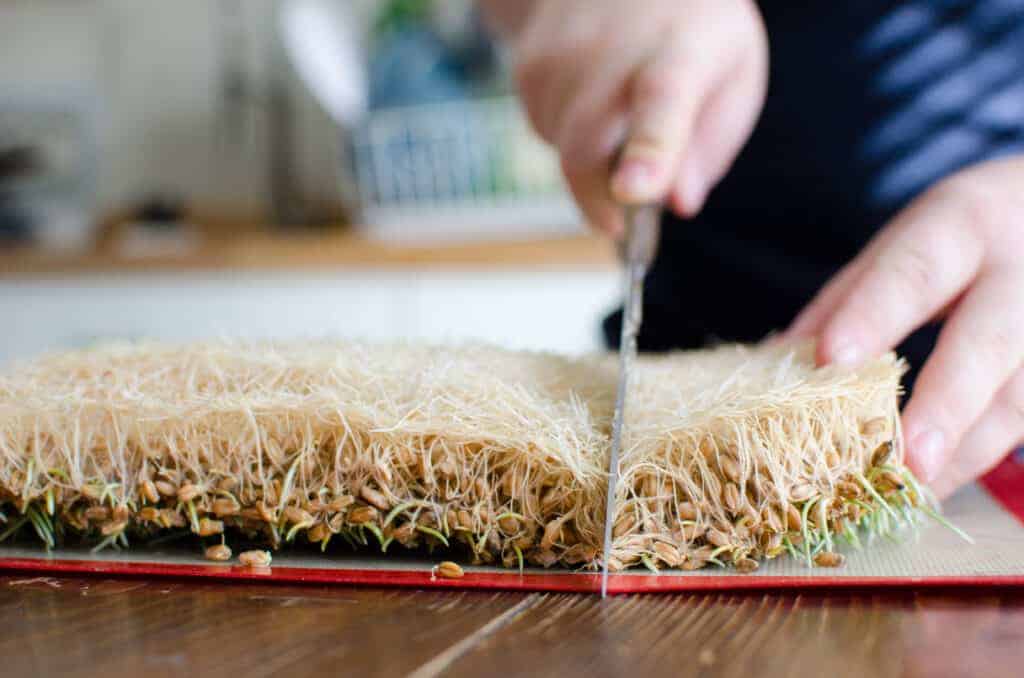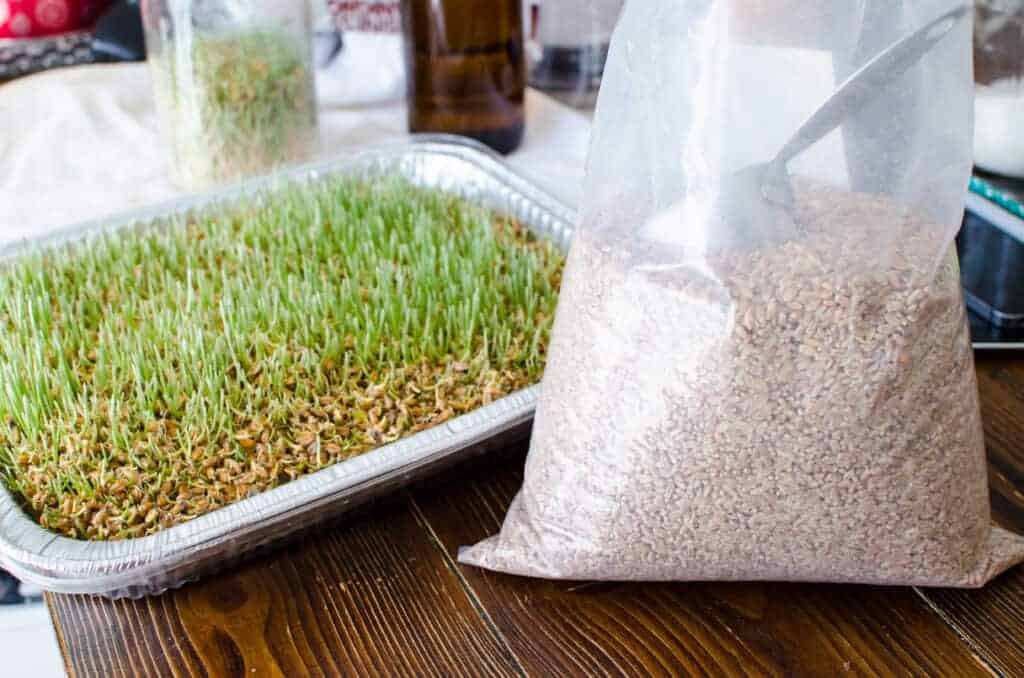What do chickens eat? Some chicken feed. A few bugs. Some grass. Fodder. Wait, what’s fodder? If you have chickens but you don’t have a yard for them to roam. Or, you have a yard but maybe you want grass all year long, even when it’s not growing. Then a chicken fodder system is a necessity on your homestead. Growing fodder for chickens is so easy, anyone can do it! Yes, that means you!.
Know this before we start: making chicken feed can be as easy or hard as you want it to be. There is no right or wrong way to do it, as long as you’re growing fodder. It can also be expensive or in-expensive as you want it to be, too.
Fodder is sprouted grains that are good for chickens’ health. But how much fodder should you give each chicken? Read this full guide to learn all about fodder and how much to feed your flock.
What is Fodder?
Fodder refers to sprouted grains that are harvested and fed to livestock after just a few days of growth. Common grains used for fodder include wheat, barley, oats, and rye. The sprouting process increases the digestibility and nutritional value of the grains significantly. Fodder is rich in vitamins, minerals, enzymes, and amino acids. It is an excellent source of nutrition for chickens.
Benefits of Feeding Fodder to Chickens
There are several advantages to incorporating fodder into your chickens’ diet:
-
Nutrition: Sprouted grains are more nutritious and digestible than unsprouted grains. The sprouting process increases protein, fiber, vitamin, and mineral content.
-
Less expensive feed: you can grow fodder with little space and effort. If you grow your own feed, you can save money on buying commercial feed.
-
Happy chickens: Chickens relish fresh, tender sprouts. Feeding fodder provides environmental enrichment.
-
Year-round fresh food Fodder gives chickens access to fresh, live food even during winter when pasture is limited.
-
Sustainable Growing fodder recycles seeds and grains while producing nutritious chicken feed with very little waste
How Much Fodder Per Chicken?
On average, chickens will consume 2-3% of their body weight in fresh fodder per day. So a 5 lb chicken will eat around 3-4 ounces of fodder daily.
However, this amount can vary based on:
-
Age of chickens: Chicks and younger pullets require more feed relative to body weight than mature chickens.
-
Production status: Laying hens and broody hens have higher nutritional needs than non-laying chickens.
-
Weather: Chickens eat more in cold weather when their bodies work harder to maintain temperature.
-
Supplementation: Fodder intake will be lower if you also feed grains, scraps, treats, etc.
-
Pasture access: Chickens with adequate pasture may not eat as much fodder.
-
Health status: Sick, injured, or stressed chickens often reduce feed consumption.
Monitor your flock and adjust amounts according to appetite. Growing fodder is simple enough that you can produce more or less as needed.
Here are some general fodder feeding guidelines:
- Chicks (1-8 weeks): 0.1-0.25 oz per chick
- Pullets (8-20 weeks): 0.25-1.5 oz per pullet
- Mature hens: 2-4 oz per hen
- Roosters: 3-5 oz per rooster
Setting Up a Chicken Fodder System
It’s easy to grow food for chickens, and you don’t need a lot of time, space, or money to do it. Here are some tips for getting started:
-
Pick a spot. You don’t need much space. A sunny corner of a garage or basement will work. Consider plumbing access for rinsing fodder.
-
Choose trays. Shallow trays like nursery flats work perfectly. Make sure they have drainage holes.
-
Soak grains. Wheat, barley, oats, and rye all make great fodder. Soak grains overnight before sprouting.
-
Spread grains. Put soaked grains in trays at a depth of 1-2 inches.
-
Rinse and drain. Rinse grains daily and allow to drain fully. Tilt trays for best drainage.
-
Add light. Natural or artificial light will speed sprouting. Aim for 12-16 hours per day.
-
Harvest fodder. Cut or trim fodder once sprouts are 2-6 inches tall.
-
Rotate trays. Start new trays every 2-3 days for a continual fodder supply.
Feeding Fodder to Chickens
Once your fodder has sprouted, it’s time to share it with your flock! Here are tips for feeding:
-
Feed fodder separately from other feed so you can monitor intake.
-
Split daily portions into multiple smaller meals.
-
Introduce fodder slowly if chickens are unfamiliar with it.
-
Chop longer sprouts into smaller pieces for easier eating.
-
Mix with treats like sunflower seeds and dried mealworms.
-
Refrigerate extra for up to 5 days. Discard moldy, smelly fodder.
-
Adjust amounts based on consumption. Don’t overload trays if chickens aren’t keeping up.
Combining Fodder with Other Feeds
You don’t have to rely on fodder alone. Combining fodder with other feedstuffs can optimize nutrition. Here are some strategies:
-
Feed fodder free-choice as a supplement to free-range chickens.
-
Use fodder to replace up to 50% of organic layer feed.
-
Mix fodder sprouts into whole grain mixes and scratch feeds.
-
Create sprout-enhanced feed by blending fodder into commercial mash or crumbles.
-
Combine fodder with kitchen scraps like chopped veggies and fruit.
Troubleshooting Common Fodder Problems
It takes a little practice to get your fodder system running smoothly. Here are some potential issues and solutions:
Grains not sprouting: Increase rinse frequency, use warmer water, add light source, and ensure grains are not too thick.
Moldy fodder: Improve air circulation and drainage. Rinse more frequently. Don’t overload trays.
Poor growth: Rinse more consistently. Use fresher seeds. Add fertilizer to soaking water.
Leggy sprouts: Provide more light exposure during sprouting for shorter, sturdier sprouts.
Low consumption: Introduce fodder slowly. Mix with preferred feeds. Adjust feeding amounts.
Benefits of Fodder Outweigh Minimal Costs
Setting up a basic fodder system requires little more than some trays, grains, and water. But the nutritional benefits can be immense. Before trying fodder, compare costs to optimize nutrition on a budget:
- Fodder equipment: $30-$60
- Grains seeds: $15-$30 per 25 lbs
- Daily water: 5-10 gallons
- Labor: less than 30 min. per day
If fed properly, the increased nutritional value of home-grown fodder can reduce feeds costs and improve flock health. The small upfront investments pay dividends through lower feed bills and improved egg and meat quality.
Start Small for Fodder Success
When first introducing fodder, start small to get a feel for labor, costs, and your chickens’ interest. Track how much you produce and how much chickens actually eat. Then expand production to match consumption. With a little observation and patience, you can find the right fodder formula to maximize nutrition for your flock.
The benefits of feeding fodder to your chickens are certainly worth exploring. Sprouted grains provide a simple, sustainable way to mimic foraging and offer nutrition that goes well beyond basic chicken feed. Follow this guide to understand optimal fodder amounts and how to successfully incorporate fodder into your chickens’ diet. Soon your flock will be feasting on trays of delicious, nutritious greens.

Steps to Growing Chicken Fodder
You can make chicken fodder as simple or as complicated as you’d like it to be. Some people just grow small batches of fodder for chickens in a sunny window during the winter months—while other people grow huge trays of fodder on large shelving racks with grow lights all year long.
That part is up to you—but the growing part is the same across the board. You’ll need just a few things to get started.
What you’ll need to grow fodder:
- Shallow container (I like these plant growing trays)
- Grains of choice (listed above)
- Water (non-chlorinated)
- Spray bottle (optional)
- Shelving (optional—if you’re doing large batches)
- Grow lights (optional)
Soak your grains of choice in a food grade bucket or bowl overnight. This will jumpstart the process.
Find a sturdy container, like these plant trays, as your base for your fodder. Old plastic or metal cake pans work well. If there are no holes in the bottom, drill lots of little holes in the bottom—big enough to allow water to drain, but small enough so that the grains don’t escape when watered. You may have to place a plastic mesh liner in the bottom of the pan if your holes are too big.
Add your soaked grains to the pan, no more than 2 inches thick. It’s best for me to add just enough so that I can’t see the pan’s bottom. Give them a nice big water under the spigot, and then let them drain before setting them in their permanent place.
Keep the grains moist, but not soaking wet, until they begin to sprout. You can do this by using a spray bottle with water, or by simply running the fodder under water each day and allowing it to drain fully. Make sure you’ve set them in a sunny place so they grow quicker.
If you want to grow them more uniformly, you can use a grow light system.
If you want the grains to drain (instead of using the spray bottle), you might consider placing a drain pan or cookie sheet under them.

The fodder will sprout nicely in 3–7 days, depending on how warm your home is or where the fodder is placed. When you want to cut the fodder to the length you want, turn it over on a clean surface and cut from the roots at the bottom. Make 4 inch squares, or desired size, and offer to your chickens as needed!.
Fodder can take a few tries to master, but once you’ve mastered it, you’ll begin putting together a constant rotational system that suits your needs.
While fodder is great, putting your chickens on pasture most of the year is your best option, if space allows. Fodder acts as a pasture replacement when pasture raising isn’t an option, or isn’t available during cold months.
If you don’t have time or space to make fodder, try sprouting wheat, broccoli, peas, or other grains and veggies in a mason jar! Simply soak them everyday in water, drain well, and watch them grow.
What Grains Can You Use to Grow Chicken Fodder?
When growing fodder for chickens, there are a few different grains you can use for sprouting. You can use just one of these grains, or a mixture of them, for your chicken fodder.
Grains you can use for fodder include:
All grains become 40% more digestible when sprouted, soaked, or turned into fodder for chickens. Your chickens will need to consume less chicken fodder than the amount of regular feed that they regularly eat simply because the nutritional value is higher. The absorption rate of the fodder into the chicken’s system is also greater and more efficient.
To learn how much feed chickens actually eat, you can read my “How Much Feed Do Chickens Eat?” blog post linked here.
Chickens need 2-3% of their body weight in fodder each day, if you’re only feeding fodder (not feed) daily. Offer it along with their grit, mineral, and vitamin supplements.

Feeding Barley Fodder to Egg Laying Chickens!
FAQ
How much fodder to feed a chicken?
If you only feed chickens fodder every day and not food, they need 2% to 3% of their body weight in fodder every day. Offer it along with their grit, mineral, and vitamin supplements.
Can chickens live off of fodder?
I use fodder to feed my chickens and rabbits. You can feed it as a complete food source or as a supplement. Grains like wheat, oats, and barley can all be sprouted for fodder. Fodder is cost effective and high in nutrients.
What is the 90 10 rule for chickens?
This rule suggests that 90% of a hen’s diet should consist of a high-quality, complete layer feed that provides a balanced and nutritious foundation. The rest of 2010 can be added to with healthy things like organic scratch grains, oyster shells, fresh vegetables, herbs, and bugs.
How much fodder do I need?
A quick and easy way to figure out how much animal feed you should give them each day is to multiply their average live body weight by the number of animals you have. Then multiply by 0. 02 to find how much fodder you would need on a daily basis in pounds.
How much fodder should a chicken eat a day?
Chickens need 2-3% of their body weight in fodder each day, if you’re only feeding fodder (not feed) daily. Offer it along with their grit, mineral, and vitamin supplements. You can make chicken fodder as simple or as complicated as you’d like it to be.
Can chickens eat fodder?
Chickens absolutely go crazy over fodder! Growing fodder for your chickens is not only healthy for your flock, but will save on your feed costs too. 1 lb. of dried grain will turn into about 7 lbs. of fodder and provide about 15x the amount of vitamins! What is chicken fodder?
What is a chicken feed calculator?
Our Chicken Feed Calculator above is a handy tool to help you determine the right amount of feed for your flock, but let’s delve a little deeper into the world of chicken feed. Whether you’re raising meat chickens or keeping chickens as pets, understanding their dietary needs is crucial.
How much food do chickens eat a day?
The amount of food that chickens eat each day is variable and depends on a range of factors, but for the sake of planning and budgeting, we need a reliable ballpark figure! Generally, one should feed chickens ¾ cup per bird per day. This rule applies to laying hens that are fed layer feed. Broilers need much more feed.
How much fodder should I Feed my flock?
Because of the space needs and time to grow, feeding fodder on a regular basis will require multiple batches growing at the same time to ensure there is always a fresh harvest to feed. How much fodder you feed to your flock will depend on you.
How do I make chicken fodder?
After you have your fodder trays set up, choose the chicken fodder seed that you would like to use to make chicken fodder. Common grains that many use are wheat, barley, oats or alfalfa. Follow the steps below. By the 7th day the grains should have sprouted about 4 inches and be ready to feed to your chickens.
